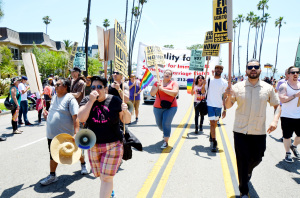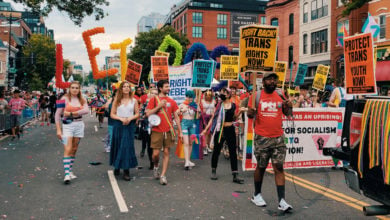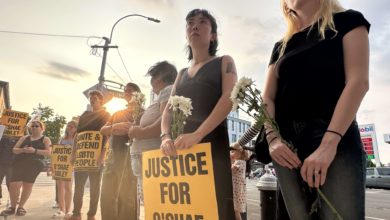
Originally published in Liberation Newspaper, June 2015
This June, the U.S. Supreme Court will make a decision on the rights of same-sex couples to marry. There is optimism the Court will rule for universal marriage equality, overturning four lower-court rulings that allowed states to ban same-sex marriage in their own states and not recognize such marriages from other states.
If the Court orders an end to marriage discrimination, the corporate media will tell a false story. They will speak of enlightened justices who are bravely taking a stand against centuries of oppression. This is a convenient narrative for the ruling class because it hides what really fuels social change: the powerful mass struggle of working and oppressed people.
There are now 38 states in which same-sex couples can get married. In 2003, there were zero. This remarkable change is not the result of the sudden appearance of better lawyers and more generous judges, but instead of the struggles of the LGBTQ community.
Generations of struggle
The Stonewall Rebellion in 1969, which launched the modern-day LGBTQ movement, was an act of resistance to the routine police harassment suffered by the community.
The decades after Stonewall included demands for full equality and recognition. Advances were made in the form of anti-discrimination laws, domestic partner benefits on the job and recognition in housing, employment and health care.
In the 1980s in particular, the LGBTQ community had to deal with the AIDS epidemic, combined with a nationwide ruling-class attack that neglected the urgent medical needs of the crisis and instead scapegoated and stereotyped gay men in the most disgusting manner. But the community’s mobilization
around AIDS and treatment won compassion and solidarity from large sections of the population. This contributed greatly to changing views towards the LGBTQ community.
Mass mobilizations on the local and national level brought national attention to the regularity of hate violence against LGBTQ people. It was these struggles that ushered in a larger transformation in popular consciousness about the conditions facing the LGBTQ community, and laid the basis for victories in the courts.
The nature of the Supreme Court
The Supreme Court is not a progressive institution. It is by design anti-democratic. The drafters of the Constitution, who were property-owning white men and mostly slave owners, created the Court as a brake on any radical change. The Court was a safeguard for the established order in case Congress or the White House became too subject to popular pressure, or racked by internal conflict. That is why the Supreme Court justices are appointed for life—so they can be, at least formally, immune from such pressures.
In truth, the Supreme Court is highly political and is far from “impartial.” One of its chief functions is to give legal cover to the dominant trends of the capitalist ruling class. Its other historical role is to keep in view the long-term interests of the system, and in that respect occasionally mandate reforms when the government’s existing policies are perceived as self-destructive.
This can be seen in two contradictory rulings. In 1896 in Plessy v. Ferguson, the Court upheld as constitutional state laws requiring racial segregation in public facilities under the doctrine of “separate but equal.” In 1954, almost sixty years later in Brown v. Board of Education of Topeka, the Court declared state laws establishing separate public schools for Black and white students to be unconstitutional.
What changed from 1896 and 1954? The all-white Supreme Court had not become anti-racist. The difference is that the intensifying struggle of the Black freedom movement posed a threat to the internal stability and global reputation of U.S. imperialism, which at this point was vying for global hegemony against a bloc of socialist states and anti-colonial movements. From inside and outside, the image of the United States as a beacon of democracy and freedom was being torn down as a fraud. A change had to be made and the result was the Brown ruling.
All throughout U.S. history, social progress has resulted from mass action outside and opposed to the institutions of state power. From the abolition of slavery to the right to unionize to women’s and LGBTQ rights, the capitalist ruling class and government have tried everything they can to hold back movements for justice and equality.
In each case, the people’s struggle grew so strong that a section of rulers came to the conclusion that fighting progressive change would just cause larger social explosions. So the rulers at the last moment changed their approach, embraced a version of reform and then turned around and presented it to the public as proof that the system “worked.”
In reality, the LGBTQ community’s breakthroughs have not come on account of the system, but won through the struggle against it.
All revolutionary and progressive people will have a reason to celebrate along with the LGBTQ community if the Court rules in favor of universal marriage rights.
If the Court rules for bigotry, the Party for Socialism and Liberation will be, alongside supporters of equality nationwide, back out in the streets.






